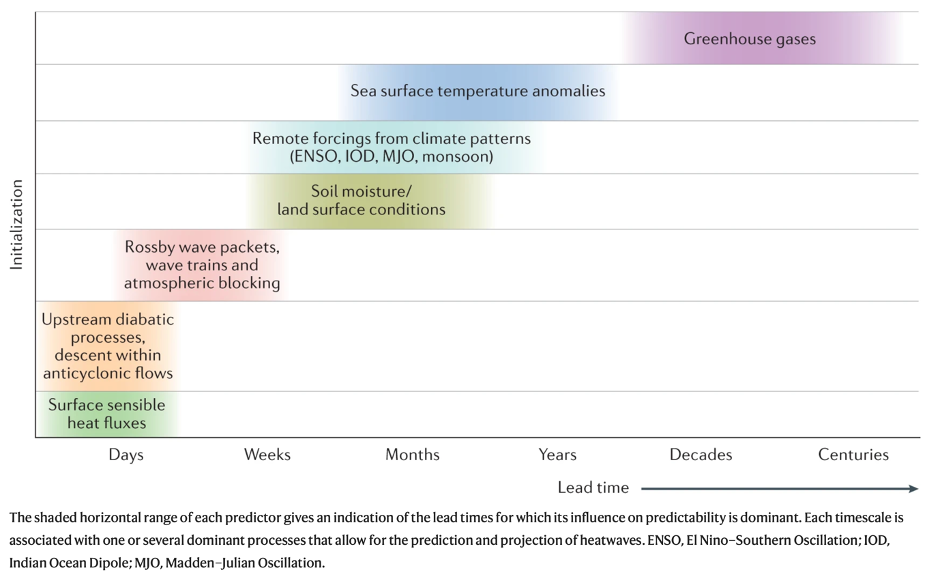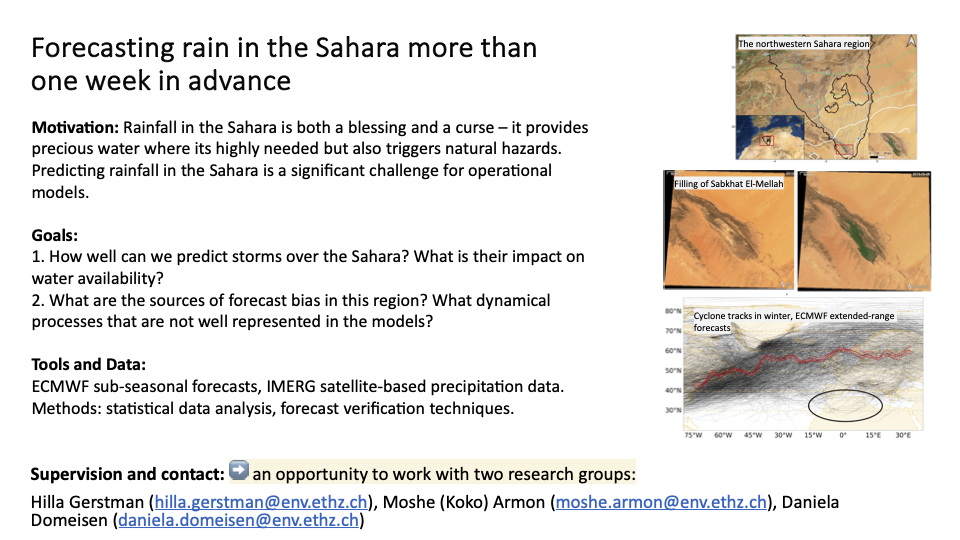Bachelor and Master Thesis
If you are interested in performing your Bachelor or Master thesis in our group, please contact Daniela Domeisen by email.
Sub-seasonal predictability of the 2022 European heatwave: relation to local and remote physical mechanisms
Over 70,000 excess deaths occurred in Europe during the summer of 2022 (Ballester et al., 2023). Considering such devastating consequences of heatwaves, readiness for these extreme events is essential at various forecast lead times. Confident predictions of heatwave onset, duration, and intensity over Europe are possible in weather prediction systems a week ahead, although some heatwaves can be predicted with lead times of 2-3 weeks (Pyrina and Domeisen, 2022; Domeisen et al., 2023). These results are encouraging, as the sub-seasonal time scale (2 weeks to 2 months) is especially relevant for issuing warnings targeted to the general population. The predictability of heatwaves in sub-seasonal time scales is dominated by processes which, among others, include the correct representation of Rossby wave packets, atmospheric blocking, and soil moisture conditions.
Goal:
The goal of this work is to quantify the predictability of the 2022 European heatwave in the ECMWF weather prediction system and assess the role of processes such as Rossby wave packets, atmospheric blocking, and soil moisture conditions for the accuracy of prediction.
Tools and Data:
ECMWF sub-seasonal forecasts, ERA5 reanalysis data, diagnostic tools developed in the Atmospheric predictability group and beyond.
Student:
The student should ideally have experience with analyzing data and plotting (e.g., python), as well as a background in meteorology and climate.
Supervision & Contact:
Maria Pyrina:
Daniela Domeisen:
Literature:
1. Ballester, J., Quijal-Zamorano, M., Méndez Turrubiates, R.F. et al. Heat-related mortality in Europe during the summer of 2022. Nat Med 29, 1857–1866 (2023). https://doi.org/10.1038/s41591-023-02419-z
2. Domeisen, D.I.V., Eltahir, E.A.B., Fischer, E.M. et al. Prediction and projection of heatwaves. Nat Rev Earth Environ 4, 36–50 (2023). https://doi.org/10.1038/s43017-022-00371-z
3. Pyrina, M., & Domeisen, D. I. (2022). Subseasonal predictability of onset, duration, and intensity of European heat extremes. Quarterly Journal of the Royal Meteorological Society, 149(750), 84-101.

On the predictability of extreme Arctic ozone depletion events and their impact on tropospheric and surface climate
Arctic ozone can be massively depleted under certain meteorological conditions, such as in spring of 2020, when the Arctic stratosphere was extremely cold and the polar vortex was strong and long- lived. Low levels of Arctic ozone in the stratosphere typically coincide with widespread surface climate anomalies in the Northern Hemisphere, such as warm and dry conditions over Northern Europe and Eurasia. In 2020, record high temperatures during spring over Siberia contributed to the widespread forest fires which burnt over 30 million acres of land. Given the relatively long time- scales of Arctic ozone depletion (~months), a potential linkage between ozone and the large-scale circulation could represent a valuable source of extended predictability. Presently, the predictability of ozone extremes has not been quantified and is the subject of this MSc project. We aim to examine the coupling between ozone and the dynamical state of the stratosphere, by exploring the influence of the polar vortex on ozone. We will evaluate the extended predictability arising from correctly forecasting ozone events, and will assess the implications for tropospheric and surface climate.
Goal and research questions:
The goal of this work will be to quantify the predictability of extreme Arctic ozone anomalies in a set of hindcast model experiments and observations. The research questions are: 1) How predictable are Arctic ozone depletion events? 2) what is the role of the polar vortex in the predictability of such events? 3) do ozone anomalies also affect the predictability of the polar vortex?
Tools and Data:
- ERA5 and MERRA2 reanalysis data will be used to assess the connection between the large-scale circulation and ozone in the observational record.
- The WACCM chemistry-climate model developed at NCAR will be the primary tool to evaluate the predictability of ozone anomalies. Existing model simulations will be used.
- If time allows for it, we could consider running another model (SOCOL) developed at ETH and PMOD. This model would allow us to evaluate the robustness of the WACCM results. The student would run the SOCOL model by her/himself.
Skills and prerequisites:
The Master student should have a strong interest in researching fundamental findings and evaluating them in an applied framework. The student should ideally have experience with plotting (e.g. python) and scientific computing, as well as a background in atmospheric dynamics (e.g. from the classes by Heini Wernli and Daniela Domeisen).
Supervision & Contact:
Gabriel Chiodo (IAC):
Daniela Domeisen (IAC):
Download Project Description Document HERE.
The role of weather regimes for streamflow droughts in Europe
Background
Streamflow droughts are periods with anomalously low river discharge. Their socio-economic and environmental impacts are far-reaching and affect, for instance, public water supply, ship transport, and river ecology. Due to the projected increase of meteorological drought frequency (i.e., periods with anomalously low precipitation) in Europe caused by anthropogenic climate change, streamflow droughts are also expected to occur more often in the future. Early-warning systems for streamflow droughts will thus be an important component of climate adaptation. However, better predictions of streamflow drought on various timescales (from days to seasons to decades) first require a better understanding of the atmospheric processes driving these events. One important such driver are weather regimes, which are quasi-stationary, persistent, and recurrent large-scale atmospheric flow patterns that drive the predominant weather conditions on a continent over several days to weeks.
Goal
The goal of this interdisciplinary master thesis will be to better understand how streamflow droughts in different regions of Europe are related to or driven by a set of 7 year-round Atlantic-European weather regimes.
Data and methods
The two underlying (already existing) datasets for this thesis will be timeseries of streamflow drought events for each region of Europe as well as a timeseries of the prevalent weather regime at each day of the past 40 years. A first step will be a correlation analysis between streamflow droughts and weather regime occurrence to better understand which weather regimes drive the onset, maintenance, and decay of streamflow drought events in different European regions. In a second part, more sophisticated statistical methods will be used (such as clustering techniques / unsupervised learning) to identify catchments that are affected by drought events under similar atmospheric conditions.
Skills and prerequisites
The student should be motivated to work in an exciting interdisciplinary project that connects atmospheric science and hydrological impacts. Previous knowledge in atmospheric dynamics and/or hydrology is thus a clear advantage. Furthermore, the student ideally has some first experience in using a programming language (preferably Python) to plot data on a map and visualize data in general.
Supervision and contact
Manuela Brunner: (Professor of the Hydrology and Climate Impacts group at ETH and SLF)
Dominik Büeler: (Postdoc in the Atmospheric Predictability group at ETH)
Daniela Domeisen: (Professor of the Atmospheric Predictability group at ETH and University of Lausanne)
Forecasting rain in the Sahara more than one week in advance
Background
Rainfall in the Sahara is both a blessing and a curse – it provides precious water where its highly needed but also triggers natural hazards. Predicting rainfall in the Sahara is a significant challenge for operational models. The project’s goal is to analyze events of extratropical storms in the arid Sahara region – and identify their impact on water availability, such as the filling of dry lakes, and assess their predictability on sub-seasonal timescales (more than one week in advance).
Goal
The goal of this master thesis is to assess how well can we predict storms over the Sahara, and what is their impact on water availability in this region. We will investigate what are the sources of forecast bias in this region and which dynamical processes are not well represented in the models.
Data and methods
The work in this master thesis project is based on new datasets of ECMWF sub-seasonal forecasts, which provide extended-range ensembles of forecasts, for a range of atmospheric variables (e.g., geopotential height, extratropical cyclones frequency and tracks, precipitation). For forecast verification and comparison with observations, ERA-5 reanalysis for the past 40 years will be used. For the hydrological part of this project, we will use IMERG satellite-based precipitation data. Additional datasets will possibly be used, depending on the project’s progress. Methods include statistical data analysis, forecast verification and various diagnostic tools that were developed in the group.
Skills and prerequisites
This is an exciting opportunity to work in an interdisciplinary project that combines topics from atmospheric predictability, dynamics and hydrology. Previous knowledge in atmospheric dynamics and/or hydrology is thus a clear advantage yet not required. Programming/data analysis experience in python/MATLAB is an advantage.
Supervision and contact
Hilla Afargan-Gerstman (; postdoc in the Atmospheric Predictability group at ETH)
Moshe (Koko) Armon (; postdoc in the Atmospheric Dynamics group at ETH)
Daniela Domeisen (; professor of the Atmospheric Predictability group at ETH and University of Lausanne)

Climate impacts on supply chains in Europe
Background
Companies with international supply chains face significant risks due to climate change. Extreme weather events such as heatwaves, cold air outbreaks and floods, can force companies to change their suppliers, find alternative routes and adapt to climate-related risks.
Goal
The goal of this master thesis are to (1) identify the impacts of climate change on supply chains in Europe and the North Atlantic, and (2) isolate the projected changes due to various extreme events (e.g., heatwaves, windstorms) for selected climate scenarios.
Data and methods
The work in this master thesis project is based on CMIP6 climate models, as well as impact modeling related to natural hazards. ERA-5 reanalysis will be used for comparison. Methods include statistical data analysis, forecast verification and various diagnostic tools that were developed in the group.
Skills and prerequisites
This is an exciting opportunity to work in a unique opportunity for an industry collaborations project with MSCI Inc (Dr. Bettina Meyer). Previous knowledge in statistics and atmospheric dynamics is thus a clear advantage yet not required. Programming/data analysis experience is an advantage.
Supervision and contact
Hilla Afargan-Gerstman: (Postdoc in the Atmospheric Predictability group at ETH)
Daniela Domeisen: (Professor of the Atmospheric Predictability group at ETH and University of Lausanne)
